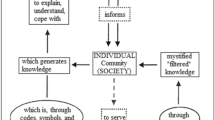Abstract
The first goal of this Project is the development of elementary school mathematics curricula sensitive to indigenous mathematical thought and experience. A necessary prerequisite for the achievement of this goal is to recapture and honor the mathematics developed and practiced in the Micronesian communities. This is the Project’s second goal. The third goal of the project is to build local capacity by offering advanced degree opportunities to the indigenous mathematics educators who transform what they find in their local cultural practices into grades 1, 4, and 7 mathematics curriculum units.

Similar content being viewed by others
Notes
The Republic of Palau, Guam, Commonwealth of the Northern Mariana Islands (CNMI); the Federated States of Micronesia (FSM) that include the states of Yap, Chuuk, Pohnpei, and Kosrae; the Republic of the Marshall Islands (RMI); American Samoa (ASamoa); and the State of Hawai‘i.
Developing effective leadership team activities, NSF grant (9819630) 1999–2002.
Mathematics education for novice teachers: opportunities for reflection, NSF grant (0138916), 2002–2008.
Jerry Fagolimul ran for and was successful in a bid to become a Senator in the Yap State Assembly. His 4-year term began in January 2011.
Donald Rubenstein, who taught this first course, is an anthropologist from the University of Guam who has vast experience with Micronesian communities over the past 25 years. He was recommended to the Project as someone who knew the Micronesian cultures from the inside having lived several times on outer islands of Yap and Chuuk. Since teaching this course, he has become a Co-PI of Project MACIMISE.
Elluminate is a web-based, interactive instructional software. The software includes several visual tools, including whiteboard, application sharing, file transfer, and web tour. The software also includes a record feature that allows the moderator to record the class for others to watch later as well as a graphing tool, breakout rooms for group work, and timer. The whiteboard supports the uploading of presentations for viewing on the whiteboard for class or meeting. Recently, Elluminate has been rebranded as “Blackboard Collaborate”.
The tapa cloth of the Pacific Islands is arguably the most refined and varied of bark-cloth art. In Samoa, tapa cloth—or siapo as it is known in Samoan—is a major art form and an important symbol of Samoan culture.
Christina Baldwin (1998). Calling the circle: the first and future culture. New York, NY: Bantam Books.
The Advisory Board is composed of international scholars in the area of Ethnomathematics: Bill Barton, Betsy Brenner, Beatriz D’Ambrosio, Ubi D’Ambrosio, Shandy Hauk, Jerry Lipka, Arthur Powell, and Katherine Ratliffe.
Persons of knowledge (aka elders) on each island have assisted the Macimisers from the start in describing, explaining, and even teaching the Macimisers the intricacies of local cultural practices.
Sakau in Pohnpei is a Micronesian variant of Polynesian kava. Sakau on Pohnpei is prepared from the root of the pepper plant by pounding the root upon a basaltic sakau stone. The pounders are also basalt, often rounded river rocks. The sakau is then squeezed through a wrap of the inner bark of the tropical hibiscus tree. The hibiscus contributes a viscous sap to the sakau. The result is a thick brown goopy liquid that is consumed from a communal coconut cup.
Author information
Authors and Affiliations
Corresponding author
Additional information
Project MACIMISE (Mathematics and Culture in Micronesia: Integrating Societal Experiences) is supported by a National Science Foundation grant (0918309). The material in this paper is based on work supported by that grant. The content does not necessarily reflect the views of the National Science Foundation or any other agency of the US government. The Project is a collaborative effort between Pacific Resources for Education and Learning (PREL) and the University of Hawai‘i-Mānoa (UHM) with PREL as the lead organization. Picture taken at the 2012 Summer Institute on Palau.
Rights and permissions
About this article
Cite this article
Dawson, A.J.S. Mathematics and culture in Micronesia: the structure and function of a capacity building project. Math Ed Res J 25, 43–56 (2013). https://doi.org/10.1007/s13394-012-0057-0
Received:
Revised:
Accepted:
Published:
Issue Date:
DOI: https://doi.org/10.1007/s13394-012-0057-0



